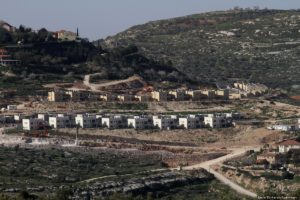Israel planning Jewish neighbourhood on land Trump slated for Palestinians

Jewish settlements near Nablus February 2015
Nir Hasson reports in Haaretz on 18 February 2020:
Israel is planning to build a Jewish neighborhood in East Jerusalem on land that would become part of the Palestinian state under U.S. President Donald Trump’s peace plan, and is currently inhabited by some 15 Palestinian families.
Ten days ago, the Construction and Housing Ministry began preparing the master plan for the new neighborhood. The neighborhood will be located at the northern edge of Jerusalem on land near the former Atarot airport and will stretch up to the separation barrier, which will be the border between the new neighborhood the Palestinian Kafr Aqab neighborhood. Though Kafr Aqab is considered to be part of Jerusalem, it is on the other side of the barrier.
The plan encompasses 1,243 dunams (nearly 310 acres) of land and is expected to include 6,900-9,000 housing units. The plan includes 300,000 square meters of commercial space and 45,000 square meters for other businesses, along with a hotel, water reservoir and other facilities.
The ownership of the land is divided among the state, the Jewish National Fund and a large number of private individuals, most of whom are Palestinians. Due to the multiplicity of landowners, the ownership of the land will have to be reapportioned – a process that the planning documents say can be carried out without the owners’ approval.
The plan does not explicitly state who the neighborhood is intended for, but it includes synagogues and Jewish ritual baths, making it clear that it is intended for a Jewish Israeli population. There are currently a number of Palestinian families living in the area planned for the new neighborhood, along with a mosque.
Since 1967, Israel has not planned or built a new neighborhood for the capital’s Arab population. The idea of building a neighborhood on the site for ultra-Orthodox Jews was considered in the past, but the Haredim rejected the idea because the neighborhood would be too far from other Jewish neighborhoods and because it is located between the separation barrier and the Atarot industrial zone. The last Jewish neighborhood Israel built in East Jerusalem was Har Homa in 1991.
The Trump peace plan’s chapter on Jerusalem includes a section titled “Special Tourist Area.” The plan specifies that “The State of Israel should allow for the development by the State of Palestine of a special tourism zone in Atarot, in a specific area to be agreed upon by the parties.”
This zone, according to the peace plan, “should be a world class tourist zone that should support Muslim tourism to Jerusalem and its holy sites,” and would include restaurants, shops, hotels, cultural centers, and other tourism facilities, along with “state-of-the-art public transportation that provides easy access to and from the holy sites.”
The “deal of the century” does not discuss exactly where this special tourism zone will be located, but the planned new neighborhood spans all the remaining unbuilt space in Atarot between the industrial area and the separation barrier.
“As we get closer to the election, [Prime Minister Benjamin] Netanyahu promotes increasingly irresponsible steps,” said Aviv Tatarsky, a researcher at the left-wing nonprofit Ir Amim. “The construction of a huge neighborhood beyond the Green Line is an attempt to create irreversible facts on the ground. Israel cannot continue doing whatever it wants forever. Sooner or later, Israel and the Palestinians will understand that an arrangement with two capitals in Jerusalem is good for all of us. In thwarting such a possibility through steps like building a huge neighborhood, Netanyahu harms Jerusalem and its residents,” he added.
This article is reproduced in its entirety
